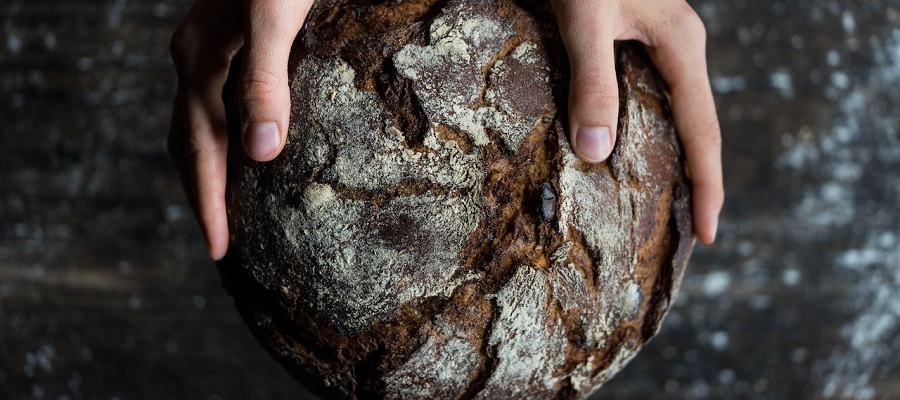Bread is a staple food that is made from flour, water, and a leavening agent, such as yeast or baking soda. It has been a staple food in many cultures around the world for thousands of years, and there are many different types of bread available, including white bread, whole grain bread, sourdough bread, and more.
Bread is a good source of carbohydrates, which provide the body with energy, and it can also be a good source of fiber, depending on the type of bread. Some types of bread, such as whole grain bread, are also a good source of other nutrients, such as protein, vitamins, and minerals.
Bread can be consumed as a standalone food, or it can be used as a base for sandwiches and other dishes. It is typically eaten at breakfast, lunch, or dinner, and can be served hot or cold, depending on the preference of the person eating it.
Overall, bread is a staple food that is made from flour, water, and a leavening agent, and it is a good source of carbohydrates and fiber, depending on the type of bread. It is consumed around the world as a standalone food or as a base for sandwiches and other dishes.
Different types of bread
There are many different types of bread available, and the specific type of bread that you choose will depend on your personal preferences and dietary needs. Here are a few examples of different types of bread:
-
White bread: White bread is made from refined wheat flour and has a soft, light texture. It is often less expensive than other types of bread, but it is generally lower in fiber and other nutrients than whole grain bread.
-
Whole grain bread: Whole grain bread is made from whole grains, such as wheat, oats, or rye, and it is a good source of fiber and other nutrients. It has a denser texture than white bread and a more robust flavor.
-
Sourdough bread: Sourdough bread is made using a starter culture of wild yeast and bacteria, and it has a distinctive sour flavor and a chewy texture. It is often considered to be more digestible than other types of bread due to the fermentation process.
-
Multigrain bread: Multigrain bread is made from a blend of grains, such as wheat, oats, and rye, and it is a good source of fiber and other nutrients. It has a denser texture and a more robust flavor than white bread.
-
Gluten-free bread: Gluten-free bread is made from grains that do not contain gluten, such as rice, corn, or quinoa, and it is suitable for people with celiac disease or a gluten intolerance.
Overall, there are many different types of bread available, and the specific type of bread that you choose will depend on your personal preferences and dietary needs.
Does eating bread affect weight?
Eating bread can affect weight, but the specific impact will depend on the type of bread that is consumed and the overall diet and lifestyle of the person consuming it.
Bread is a source of carbohydrates, which provide the body with energy. Consuming too many calories from any source, including bread, can contribute to weight gain if the body is not using those calories through physical activity or other means.
However, it is important to note that not all types of bread are created equal, and some types of bread may be more likely to affect weight than others. For example, white bread, which is made from refined wheat flour, may be less filling and less nutrient-dense than whole grain bread, which is made from whole grains and is a good source of fiber and other nutrients.
Overall, the impact of bread on weight will depend on the type of bread consumed and the overall diet and lifestyle of the person consuming it. It is important to choose a variety of nutrient-dense foods and to consume them in moderation as part of a healthy, balanced diet. If you are concerned about your weight, it may be helpful to speak with a healthcare professional or a registered dietitian for personalized advice.
Which country makes the best bread?
It is difficult to say which country makes the best bread, as bread is a staple food that is enjoyed in many different countries around the world, and each country has its own unique bread traditions and styles. Different countries may be known for producing different types of bread, depending on the local ingredients and culinary traditions.
For example, France is known for its wide variety of breads, including baguettes, croissants, and brioche. Italy is known for its artisanal breads, including ciabatta, focaccia, and pizza dough. Germany is known for its rye breads and pretzels. The United States is known for its wide variety of breads, including white bread, whole grain bread, and sourdough bread.
Overall, it is difficult to say which country makes the best bread, as bread is a staple food that is enjoyed in many different countries around the world, and each country has its own unique bread traditions and styles.
Prices of different types of bread
The price of different types of bread can vary depending on a variety of factors, including the type of bread, where it is purchased, and the location. Here are a few general guidelines for the price range of some common types of bread:
-
White bread: White bread is typically less expensive than other types of bread, and prices can range from $1 to $3 or more, depending on the size of the loaf and the location.
-
Whole grain bread: Whole grain bread is typically more expensive than white bread, and prices can range from $2 to $5 or more, depending on the size of the loaf and the location.
-
Sourdough bread: Sourdough bread is often more expensive than other types of bread due to the time and effort required to make it, and prices can range from $3 to $7 or more, depending on the size of the loaf and the location.
-
Multigrain bread: Multigrain bread is typically more expensive than white bread, but it is generally less expensive than whole grain bread or sourdough bread. Prices can range from $2 to $4 or more, depending on the size of the loaf and the location.
-
Gluten-free bread: Gluten-free bread is often more expensive than other types of bread due to the specialized ingredients and production process, and prices can range from $4 to $8 or more, depending on the size of the loaf and the location.
Overall, the price of different types of bread can vary, but whole grain bread, sourdough bread, and gluten-free bread are generally more expensive than white bread, while multigrain bread is generally less expensive than whole grain bread or sourdough bread.


